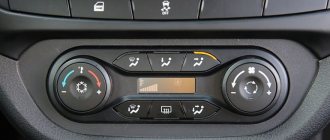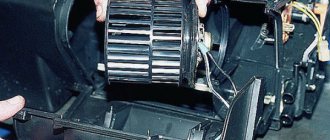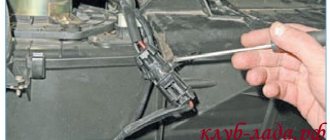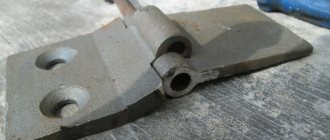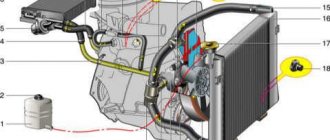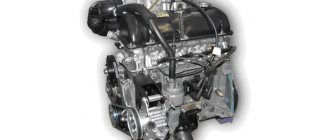Comfort in the cabin when operating the car in winter is ensured by a stove in the cabin. Before the advent of the “tenth” family of models, AvtoVAZ equipped its cars with a simple mechanically controlled heating system. Starting with the VAZ-2110 model, designers revised the design of the stove and improved its control mechanism. Such modifications increase the convenience of adjusting the heating operation, and sometimes cause failure or improper functioning of the interior heating.
The design of the heating system of the VAZ-2110
The concept of interior heating on the VAZ-2110 remains the same - the air supplied to the cabin is heated by the cooling system. To do this, a radiator is installed in the cabin, under the front panel, which is included in the cooling system; heated antifreeze moves through it. The air passing through the radiator is supplied through the air intake. After heating, the air flow through the air ducts is supplied to the necessary areas - the windshield, legs, torso.
Forced air circulation is provided, which increases the efficiency of the distribution of warm flow throughout the cabin. For this purpose, the stove is equipped with a fan driven by an electric motor.
The air heating temperature is regulated by dampers. One of them allows the flow either through the radiator (for heating) or bypassing it. The damper divides the flow to obtain the desired temperature - one part of it goes through the radiator, and the second bypasses it, after which it is mixed, the degree of heating is regulated and supplied to the air ducts.
The second damper is designed to shut off the air supply to the cabin from the outside. Thanks to it, a closed air circulation mode is established.
↑ Heater air ducts and control parts
1 – air ducts for heating the rear part of the cabin; 2 – floor tunnel lining 3 – foot heating ducts; 4 – central cabin ventilation nozzles; 5 – side nozzles for interior ventilation; 6 – nozzles for heating the windows of the front doors; 7 – control lever for the interior heating system; 8 – air distributor housing; 9 – foot heating damper; 10 – windshield heating flap; 11 – heater
Stove control
Previously, the dampers on VAZ were controlled mechanically - the damper was connected by a cable to a handle on the heater control unit. Additionally, the heater was equipped with a tap to shut off the supply of antifreeze to the heater radiator, which was regulated by a handle on the control unit.
Video: The stove on the VAZ 2110 does not heat up? Replacing the heater damper gearmotor
On the VAZ-2110, the shut-off valve is no longer installed, and the heater is turned off in the summer using a damper, which, when completely closed, separates the radiator from the passenger compartment. The mechanical control of the dampers was replaced with an electromechanical one - a micromotor gearbox was installed. Heating control for VAZ-2110 includes:
- controller of the automatic heater control system (AHC);
- temperature sensor;
- damper position sensor;
- micromotor gearbox
The controller is equipped with a front panel with two handles - the left one is responsible for adjusting the temperature, the right one is for operating the fan. Models of the 10th family use controllers, the difference between which comes down to the number of fan operating modes and the presence of an automatic operating mode.
↑ Heater parts
1 – electro-pneumatic valve; 2 – front housing of the heater air intake; 3 – water deflector flap of the air intake; 4 – recirculation damper control valve 5 – air intake recirculation damper; 6 – rear heater air intake housing; 7 – heater channel damper; 8 – heater control damper; 9 – radiator; 10 – heater radiator casing; 11 – fitting for steam exhaust hose; 12 – supply hose fitting; 13 – outlet hose fitting; 14 – heater electric motor with fan; 15 – electric motor housing; 16 – support platform for the heater control damper drive lever; 17 – heater control damper drive lever; 18 – micromotor gearbox for damper drive; 19 – resistor; 20 – heater casing cover
Principle of operation
The operating principle of such a control system is simple - the driver uses the left handle to set the desired temperature (completely cold or in the range from 16 to 28 degrees). Based on the set mode, the controller supplies power to the micromotor gearbox and it sets the dampers to the desired position.
Two-way communication is used between these elements - a position sensor is installed on the gearbox, which “informs” the controller about the opening angle. Thanks to the installed temperature sensor (located on the ceiling), the controller constantly monitors the degree of heating of the air in the cabin, based on which it adjusts the position of the damper to maintain the temperature set by the driver.
Temperature sensor VAZ 2110
Thanks to the use of automatic control system, the driver no longer needs to adjust the operation of the stove in order to maintain a comfortable temperature; he sets the temperature with a handle, and the controller does the rest. On the early VAZ-2110, the heater fan had three operating modes, the difference between which comes down to the rotation speed. Speed adjustment is carried out by installing a rheostat block in the power supply circuit of the electric motor. Then models appeared in which the fan received a 4th operating mode - automatic. When it is turned on, the fan operates under the control of the controller - the ACS regulates the rotation speed of the electric motor to adjust the temperature in the cabin.
The use of electromechanical control on the VAZ-2110 increased the convenience of controlling interior heating, but due to the more complex design, the likelihood of stove failure increased.
Temperature sensor faulty
Quite often the following problem occurs: you cannot correctly adjust the temperature in the cabin because the sensor located near the light bulb has failed or is not calibrated. Most often, the problem is a failure of the control unit, as well as incorrect position of the damper. Fortunately, all this can be solved quite simply; you only need a little time and a tool. The first step is to diagnose the serviceability of the temperature sensor. This can be done as follows: move the heating control knob to one side, and then to the opposite. In this case, the temperature of the air entering the cabin should change.
If the temperature changes, but the VAZ-21102 stove still does not heat well, then the problem is not with the controller. If there are no changes, it makes sense to replace the sensor or simply try to turn it off and check the functionality of the heater. If the controller is turned off, air will flow into the cabin at the temperature that was set on the electronic unit. In simple terms, this is how you can disable “A” mode on the fan. Well, now let's go further and look at a few more malfunctions of the stove on the “ten”.
Malfunctions of the VAZ 2110 stove and their elimination
VAZ-2110 owners are faced with the problem of a non-working or malfunctioning stove. The malfunction boils down to the fact that the air does not heat up, the heater supplies hot air, or there is uneven heating - cold air goes to the windshield, but well-heated air goes to the foot area.
Why does the stove not heat well?
These symptoms occur due to a malfunction in the stove control system:
- Damage to the ACS controller.
- Malfunction of the micromotor gearbox.
- Damper deformed or jammed.
- Temperature sensor malfunction.
To identify the problem, first determine in which branch of the control system the malfunction occurred. To do this, start the engine, turn on the heater fan at maximum speed, and then turn the temperature control knob from “Min” to “Max” and listen to whether the noise changes from the fan operation. If the “controller-gearbox” branch is working properly, then the dampers move, and by changing the direction of air flow, the noise from the stove operation changes in tone.
But if the sound of operation does not change, the reason lies in the controller, gearbox or dampers.
To check the controller, replace it with a known good one and check whether the operation of the stove has changed. The next thing to check is the gear motor. The difficulty of checking is that it is located under the “jabot” on the engine side, and it is difficult to get to the gearbox. This control branch may not work due to jammed dampers.
To check the “controller-temperature sensor” branch, disconnect the wires from the sensor. Without its readings, the controller controls the damper based on the temperature set by the driver. If the problem with the operation of the stove lay in the temperature sensor, then after it is turned off, the normal functioning of the heating system will be restored, with the only difference that the automatic fan mode will stop working and the ACS will not be able to adjust the temperature of the air flow.
More often, problems arise with the controller and gearmotor. These units can be repaired, but since their price is low, it is easier to replace them with new ones.
Video: The stove on the VAZ 2110 does not heat up? Heater damper repair
Introduction
It is impossible to independently repair your own car without knowledge regarding the structure of all components. The skill of reading any drawings is considered equally valuable. Such skills can only be acquired by having certain experience, which comes over the years in the process of operating and maintaining your car. In the article below we will look at the design of the VAZ-2110 heater.
It is no secret that a properly functioning heater device in the top ten of the domestic automobile industry allows the driver and passengers to feel as comfortable as possible while driving. The article discusses the connection diagram of the unit and provides a description of the elements that make up the stove. The information can be useful not only to novice amateur mechanics, but also to experienced craftsmen who have difficulties repairing the heater.
Other reasons
The problems associated with stove control are described above. But the stove may not work or not function efficiently enough for other reasons:
- the appearance of an air lock in the heater radiator;
- radiator clogged;
- severe wear or breakdown of the fan motor;
- malfunction of the rheostat block of the control mechanism;
- damper deformation.
These malfunctions affect the performance of the stove. On the VAZ-2110 they occur less frequently than control system breakdowns, but they should also be taken into account. To identify the reason for the cessation of normal operation of the VAZ-2110 stove, determine why this could have happened. If the fan does not work, then to fix the problem, check it, the rheostat unit and the power circuit.
The stove blows cold air - the reason lies in the stove radiator (clogged, a plug has formed in it) or in the dampers (jammed in a position where the air flow bypasses the radiator).
The stove heats poorly and it is not possible to adjust the temperature - check the functionality of the controller, micro-reducer and temperature sensor.
To identify the cause and eliminate the decrease in stove productivity, move “from simple to complex.” First, check the functionality of the system elements located in the cabin (controller, temperature sensor), and then climb under the hood to diagnose the operation of the gearbox, dampers, and fan motor.
The stove does not heat the air well or the airflow is not of sufficient quality
Sometimes the air heats up very slowly, which is clearly not a delight, especially in severe frosts. In addition, it also happens that the quality of the warm flow is not very satisfactory. In this case, it is necessary to replace the plastic damper with an aluminum one. The latter costs a little more, but its efficiency is many times higher. As practice shows, many drivers are faced with the fact that the old-style damper bends during operation, which leads to loss of heated air. If you are willing to pay for heat in the cabin, then purchase a heater from a VAZ-2112. It is slightly better, although it may not have a cleaning filter or will not have a recirculation function (depending on the model).
You can also purchase an antifreeze heater. It is needed to preheat the engine and car interior. If you are not satisfied with how well the air is supplied to the side windows and under your feet, then you can easily improve the system yourself. We have already told you how to do this. Please note that the nozzles may be either blocked by something or clogged. So, drivers often cover them with mats without knowing it. But all this is quite easy to fix, you just need to devote a little time. As you can see, if the VAZ-2110 stove (injector) does not heat well, then there can be a whole host of reasons. Most often, everything can be fixed on your own.

